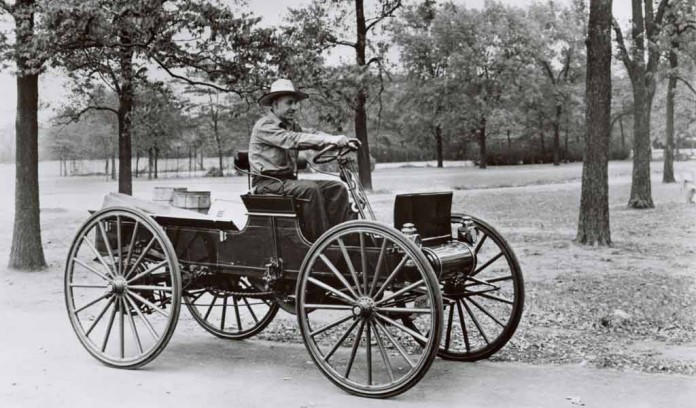
This week is the rest of a list of what I consider to be the 10 most significant new developments in agricultural machinery during the 19th century and the first half of the 20th. (Read the first part of the list.)
I didn’t include anything about plows or other tillage machines because, even though such implements were greatly improved during the period by John Deere and others, that’s all they were — improvements to already existing machines.
Some of which had been around for centuries.
There have been so many improvements and drastic changes in farming machinery and techniques in the almost seven decades since 1950 that I don’t know that it would be possible to pick out “ten best,” but I’ll leave that to others.
6. Auto truck
Machinery, critters and crops, among other heavy things, all need to be moved around the farm, or to market.
Two wheeled carts sufficed for early farmers. Soon 4-wheeled wagons became the norm and were universally used for a couple of centuries.
It’s impossible to pin down the first motor truck, but steam, electric and gasoline powered commercial vehicles made their appearance about the end of the 19th century, and by 1910 were common in urban areas.
The first real attempt to make a vehicle to replace the ubiquitous farm wagon was International Harvester with their “Auto Wagon,” which was introduced in 1907.
Since that time farm trucks of all sizes have proliferated and today, no self-respecting farmer is without his pickup.
7. Gasoline tractor
Steam tractors required much water, lots of coal, wood, or straw for fuel, and a trained engineer to operate. The internal combustion engine that was being perfected during the 1890s offered an alternative to steam.
John Froelich is generally credited with inventing the first successful tractor in 1892.
The first commercially successful tractor was built in Charles City, Iowa, by Charles Hart and Charles Parr.
Early gas tractors were big, heavy, awkward and none too reliable, but by 1920 the better ones had survived, had been greatly improved, and were becoming hugely popular on American farms for heavy tillage and belt work.
8. General purpose tractor
During the 1920s, row crop work such as planting and cultivating were still largely done by horses as tractors were too heavy and not versatile enough for those lighter jobs.
Several lightweight row crop tractors had been tried, but most were not satisfactory. Several manufacturers offered motor cultivators during the ‘teens, but few farmers were willing to buy an expensive machine that was used only a month or two each year.
In 1924, IH introduced the Farmall, the first real general purpose tractor that could pull heavy tillage and harvesting machines, as well as plant and cultivate row crops. The Farmall quickly caught on and by 1930 IH was churning out 200 Farmall tractors per day.
Soon, every major tractor manufacturer offered a similar row crop machine. The swift mechanization of American farms that occurred during the late 1930s and early 1940s was on its way.
9. Rubber tires
Steel lugged wheels limited speed, vibrated and shook bolts loose, and quickly dug themselves into soft ground if they spun — not to mention what they did to the driver’s innards and backs.
Solid rubber tires began to be fitted to industrial tractors about 1920, and Florida citrus growers experimented with large truck tires on tractors in 1928. Harry Merritt from Allis-Chalmers got Harvey Firestone interested and, in 1932, large, low-pressure tires were fitted to an Allis-Chalmers U owned by Wisconsin farmer Albert Schroeder.
The tires were a huge success and A-C began to offer air tires on the Model U tractor late in 1932, a first in the industry. The advantage of pneumatic tires over steel wheels in fuel economy and performance — not to mention driver comfort — sold farmers on their advantages, and by 1940, 95 percent of tractors were ordered on rubber.
Harvey Firestone’s dream of putting the farm on rubber was on its way to being reality.
10. Hydraulic implement lift with draft control
The first tractor mechanical lift appeared in 1927, and a hydraulic lift in 1934. These lifts, however, were just that — lifts.
They raised the implement without the operator having to wrestle a hand lever, but it dropped by gravity and depth control still required frequent manipulation of a lever or crank.
Irishman Harry Ferguson can claim credit for the first hydraulic lift with automatic draft control. By 1933, he had perfected a way of attaching an implement to a tractor by three arms.
The tension load on the lower draft arms and the compression load on the upper link arm caused the “virtual hitch” point to be near the tractor’s front axle, thus keeping the front end of the tractor on the ground. In addition, the top link compression load operated a hydraulic valve that caused the implement depth to be automatically regulated according to the draft needed to pull it.
Ferguson’s three-point hitch was probably the most revolutionary improvement in tractor and implement technology during the first half of the 20th century.
Today, virtually every tractor sold anywhere in the world features a three-point hitch based on Ferguson’s system.
So, there’s my list. I’d be interested in hearing whether readers agree, or think I’m crazy, so be sure to let us know.












